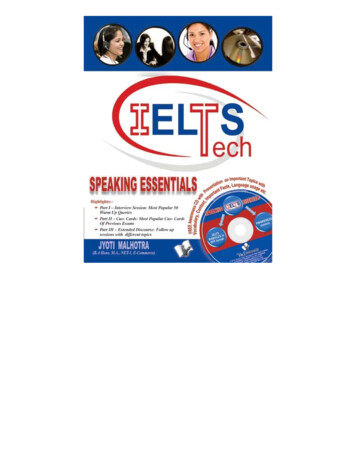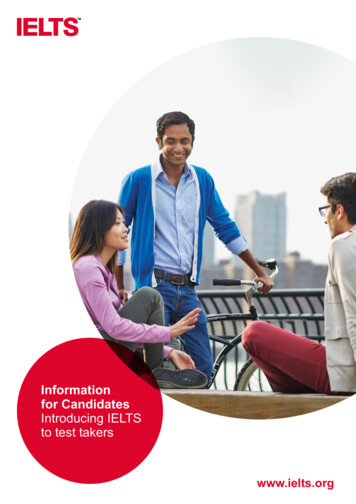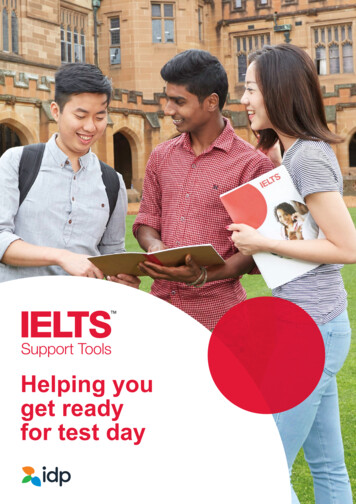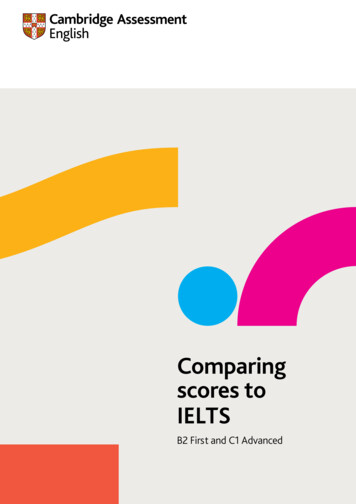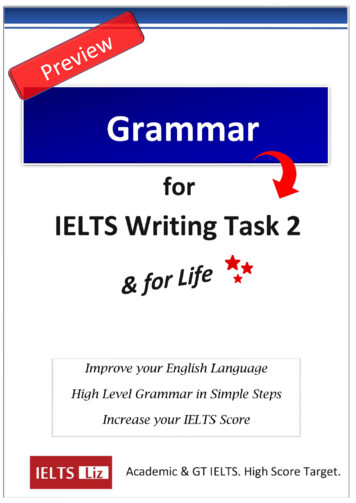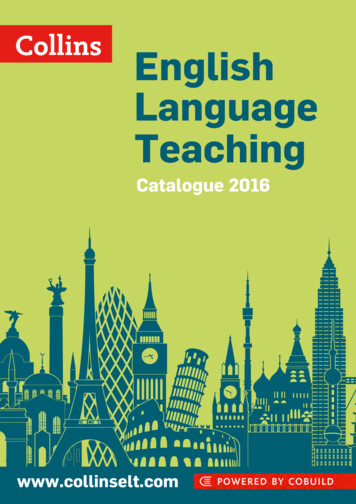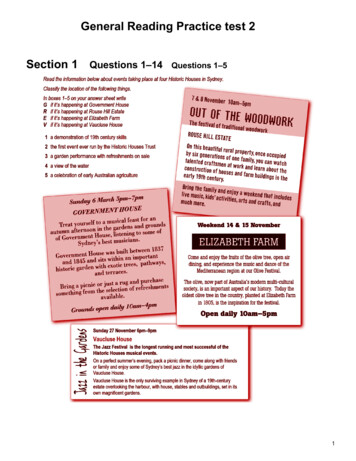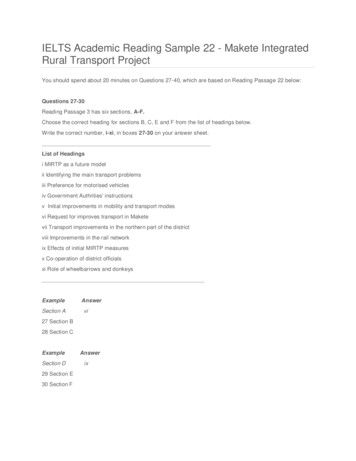
Transcription
IELTS Academic Reading Sample 22 - Makete IntegratedRural Transport ProjectYou should spend about 20 minutes on Questions 27-40, which are based on Reading Passage 22 below:Questions 27-30Reading Passage 3 has six sections, A-F.Choose the correct heading for sections B, C, E and F from the list of headings below.Write the correct number, i-xi, in boxes 27-30 on your answer sheet.List of Headingsi MIRTP as a future modelii Identifying the main transport problemsiii Preference for motorised vehiclesiv Government Authrities' instructionsv Initial improvements in mobility and transport modesvi Request for improves transport in Maketevii Transport improvements in the northern part of the districtviii Improvements in the rail networkix Effects of initial MIRTP measuresx Co-operation of district officialsxi Role of wheelbarrows and donkeysExampleSection AAnswervi27 Section B28 Section CExampleSection D29 Section E30 Section FAnswerix
Makete Integrated Rural Transport ProjectSection AThe disappointing results of many conventional road transport projects in Africa led some experts to rethink thestrategy by which rural transport problems were to be tackled at the beginning of the .1980s. A request for helpin improving the availability of transport within the remote Makete District of southwestern Tanzania presentedthe opportunity to try a new approach.The concept of’ integrated rural transport was adopted in the task of examining the transport needs of the ruralhouseholds m the district The objective was to reduce the time and effort needed to obtain access to essentialgoods and services -through an improved rural transport system. The underlying assumption was that the timesaved would be used instead for activities that would improve the social and economic development of thecommunities. The Makete Integrated Rural Transport -Project (MIRT P) started in 1985 with financial supportfrom the Swiss Development Corporation and was coordinated .with the help of the Tanzanian government.Section BWhen the project began. Makete District was virtually totally isolated dunng the rainy "sensory. The regionalroad was in such bad shape that access to the main towns was impossible for about three months of the year.Road traffic was extremely rare with the district, and alternative means of transport were restricted to donkeysin the north of the distinct people relied primarily on the paths, which were supper and dangerous during therains.Before solutions cook be proposed, the problems had to be understood. Little was known about the transportdemands of the rural households, so Phase I. between December 1985 and December 1987, (ocused'onresearch. The socio-economic survey of more then 400 households in the district indicate of that a householdin Makete spent, on average, seven hours a day on transporting themselves and their goods, a figure whichseemed extreme but which has also been obtained in surveys in other rural areas in Africa. Interesting factsregarding transport were found; 95% was on foot 80% was within the locality: and 70% was related to thecollect on of water and firewood and travelling to gunning mills-Section CHaving determined the main transport needs, possible solutions were identified which might reduce the timeand burden During Phase II. from January to February 1991, a number of approaches were implemented in aneffort to improve mobility and access to transportAn improvement of the rotted network was considered necessary to ensure the import and export of goods to
the distinct These improvements were carried out using methods that were heavily dependent on labour. Inaddition to the improvement of roads, these methods provided training in the operation of a mechanicalworkshop and bus and truck services Hoverer. the difference from the conventional approach was that this timeconsideration was given to local transport needs outside the road network.Most goods were transported along the paths that provide short-cuts up and down the hillsides, but the pathswere a real safety ask and made the journey on foot even more arduous. It made sense to improve the pathsby building steps, handrails and footbridges.It was uncommon to fixit means of transport that were more efficient than walking but less technologicallyadvanced than motor vehicles. The use of bicycles was constrained by their high cost and the lack of availablespare parts. Oxen were not used at all but donkeys were used by a few households in the northern part of thedistrict MIRTP focused on what would be most appropriate for the inhabitants of Makete in terms of what wasavailable, how much they could afford and what they are willing to accept After careful consideration, theproject chose the promotion of donkeys - a donkey costs less than a bicycle - and the introduction of a locallymanufacturability wheelbarrow.Section DAt the end of Phase II, it was dear that the selected approaches to Makete's transport problems had haddifferent degrees of success. Phase III. from March 1991 to March 1993, focused on the refinement andmust of these activities. .The road improvements and accompanying maintenance system had helped make the district centreaccessible throughout the year. Essential goods from outside the district had become more readily available atthe market and prices did not fluctuate as much as they had done before.Paths and secondary roads were improved only at the request of communist who were willing to participate inconstruction and maintenance. However, the improved paths impressed the inhabitants, and requests forassistance greatly increased soon after only a few improvements had been completed.The efforts to improve the efficiency of the existing transport services were not very successful because mostof the motorised vehicles in the district broke down and there were no resources to repair, them. Even theintroduction of low-cost means of transport was difficult because of the general poverty of the district Thelocally manufactured wheelbarrows were still too expensive for all but a few of the households. Modifications tothe original design by local carpenters cut- production time and costs. Other local carpenters have been trainedin the new design So that they can respond to requests. Nevertheless, a locally produced woode n wheelbarrow
which costs around 500QTanzanian shillings (less than US 20) in Makete, and is about one quarter the cost ofa metal wheelbarrow, is still too expensive for most people.Donkeys, which were imported to the district have become more common and contribute, in particular, to thetransportation of crops and goods to market Those who have bought donkeys are mainly from richerhouseholds but with an increased supply through local breeding, donkeys should become more affordable.Meanwhile, local initiatives are promoting the renting out of the existing donkeys.It should be noted, however, that a donkey, which at 20,000 Tanzanian shillings costs less than a bicycle, is stillan investment equal to an average household's income over half a year. This dearly illustrates the need forsupplementary measures if one wants to assist the rural poor.Section EIt would have been easy to criticize the MIRTP for using in the early phases atop-down' approach, in whichdecisions were made by experts and officials before being handed down to communities, but it was necessaryto start the process from the level of the governmental authorities of the district It would have been, difficult torespond to the requests of villagers and other rural inhabitants without the support and understanding of districtauthorities.Section FToday, nobody in the district argues about, the importance of improved paths and inexpensive means oftransport But this is the result of dedicated work over a long penned particularly from th e officers in charge ofcommunity development They played an essential role in raising awareness and interest among the ruralcommunities.The concept of integrated rural transport is now well established in Tanzania, where a major program of ruraltransport is just about to start The experiences from Makete will help in this initiative, and Makete Distinct willact as a reference for future work.Questions 31-35Do the following statements agree with the claims of the writer in reading passage 154?In boxes 31-35 on your answer sheet write:YES if the statement agrees with the claims of the writerNO if the statement contradicts the claims of the writerNOT GIVEN if it is impossible to say what the writer thinks about this
31 MIRTP was divided into five phases.32 Prior to the start of the MIRTP the Makete district was almost inaccessible during the rainy reason.33 Phase I of MIRTP consisted of a survey of household expenditure on transport.34 The survey concluded that one-fifth or 20% of the household transport requirement as outside the localarea.35 MIRTP hopes to improve the movements of goods from Makete district to the country's capital.Questions 36-39Complete each sentence with the correct ending, A-J,below.Write thecorrect letter, A-J,in boxes 36-39 on your answer sheet.36 Construction of footbridges, steps and handrails37 Frequent breakdown of buses andtrucks in Makete38 The improvement of secondary roads and paths39 The isolation of Makete for part of the yearQuestion 40Choose the correct letter.A, B, C or D.Write the correct letter in box 40 on your answer sheet.Which of the following phrases best describes the main aim of Reading Passage 154 ?
A to suggest that projects such as MIRTP are needed in other countriesB to describe how MIRTP was implemented and how successful it wasC to examine how MIRTP promoted the use of donkeysD towarn that projects such as MIRTP are likely to have serious problemsAnswer:27 ii28 v29 x30 i31 NO32 YES33 NO34 YES35 NOT GIVEN36 D37 I38 G39 E40 B
IELTS Academic Reading Sample 22 - Makete Integrated Rural Transport Project You should spend about 20 minutes on Questions 27-40, which are based on Reading Passage 22 below: Questions 27-30 Reading Passage 3 has six sections, A-F. Choose the correct heading for sections B, C, E and F from the list of headings below.


